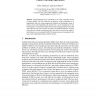Free Online Productivity Tools
i2Speak
i2Symbol
i2OCR
iTex2Img
iWeb2Print
iWeb2Shot
i2Type
iPdf2Split
iPdf2Merge
i2Bopomofo
i2Arabic
i2Style
i2Image
i2PDF
iLatex2Rtf
Sci2ools
CP
2008
Springer
2008
Springer
Experimenting with Small Changes in Conflict-Driven Clause Learning Algorithms
Experimentation of new algorithms is the usual companion section of papers dealing with SAT. However, the behavior of those algorithms is so unpredictable that even strong experiments (hundreds of benchmarks, dozen of solvers) can be still misleading. We present here a set of experiments of very small changes of a canonical Conflict Driven Clause Learning (CDCL) solver and show that even very close versions can lead to very different behaviors. In some cases, the best of them could perfectly have been used to convince the reader of the efficiency of a new method for SAT. This observation can be explained by the lack of real experimental studies of CDCL solvers.
Artificial Intelligence | Conflict Driven Clause | CP 2008 | Small Changes | Usual Companion Section |
| Added | 18 Oct 2010 |
| Updated | 18 Oct 2010 |
| Type | Conference |
| Year | 2008 |
| Where | CP |
| Authors | Gilles Audemard, Laurent Simon |
Comments (0)

